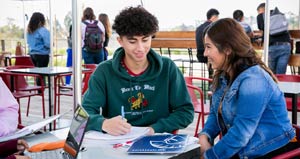
Five Activities You Can Do in Your Class Next Week That Require Little or No Preparation
By Professor Sean Dailey
How do you and your students feel on Monday morning? Sometimes it’s difficult to get students to wake up, let alone motivated to learn English at the beginning of the week. This short article describes five activities that work in your classroom, require little or no preparation, and have students talking, engaging, and interacting with each other (even at the beginning of the week)! I have used each of these activities in university-level, required English courses in South Korea, but some of them actually came from my time as an elementary school teacher. Because teaching contexts and proficiency levels of students vary greatly, considerations are made for appropriate levels or ways to differentiate these activities for mixed-ability classes; the idea is to try to include something for everyone. I have always thought that one mark of a skilled teacher is the ability to take an activity or observation made in a classroom and adapt it to make it their own. That is exactly what I have done here with almost all of these activities, and I encourage you to do the same. Without further ado, I present to you these five awesome activities that you can use in your classroom next week!

Photo by NeONBRAND on Unsplash
1. Warmups
The first activity is actually a brief list of warm-ups that cost you minimal preparation with maximum reward. Warm-ups are activities that set the pace for the rest of the lesson, gradually ease students into using the target language in class, and review or preview lesson content; therefore, teachers should never underestimate the advantage of using a strong warm-up in a language class. So this first “activity” is actually more bang for your buck because you get a few of my favorite warm-ups!
a. A-Z Relay Race Game
The teacher writes the alphabet on the board and splits the class into 2 (or more) teams. Each team should have a different color board marker. Teams line up in front of the board and compete in a relay race format. The objective is to fill up the board with vocabulary about the topic of the lesson with all teams competing at the same time. If one team has already started writing a word that begins with a particular letter, then the other team(s) has to choose a different letter to start their word. The game is over when there is a word for every letter of the alphabet, and the winning team is the one with the most vocabulary words. The colored markers make it easier to tally the scores at the end of the game.
Some ways to differentiate this activity would be pairing strong and weak students together on the same team, having students work together or separately at their desks using this slightly different format for the game, allowing students to use the letter anywhere in their vocabulary word (e.g. A=Apple or A=cArrot if the topic is food), evaluating the spelling of the vocabulary words, allowing or forbidding students to help teammates with word ideas or spelling, and making teams explain their rationale for some of their less obvious word choices.
b. Name 10
Students compete to be the first to come up with a list of 10 items related to the lesson topic for the day (or the previous lesson). Some ways to differentiate this activity include using a timer, changing the requirements to “Name 5”, allowing students to work together, allowing students to use their L1, etc.
c. Make a Story
This is one of my favorite activities. The teacher projects an interesting image onto the screen (this is one of my favorite images to use) and students work together to write a short story. I usually keep the story limited to 3-5 sentences, but that can depend on the proficiency level of the students. Some ways to differentiate this activity are to have students write complete sentences or only short notes, change the sentence requirement, work alone or in pairs, or use verbal output only. You will be delighted by the imaginative stories that your students create!
d. Word Association
The teacher presents the topic and Student A has to say the first word that comes to mind. Student B listens to Student A’s word and then says the first word that comes to mind. Repeat until all students have said a word. Some ways to differentiate this activity are to allow students extra time or turn it into game where a student is “out” if they cannot come up with a word in 3 (or 5, etc.) seconds.
2. Survey-style Activities
Nothing is better for waking students up on a Monday morning than getting them out of their seats and moving around. This type of activity (also called “Find Someone Who”) requires a bit of preparation beforehand but can easily be tailored to suit the lesson topic, age, or proficiency level of your students. Although this activity can work with all ages and proficiency levels, it certainly works better with older students or when done a bit later in the semester/year if working with absolute beginners. Here is a brief explanation and example of the survey activity!
3. Photo Sharing / 3,2,1
Many teachers differ on their policies for the use of mobile devices in the classroom. Sometimes administration even has certain rules that teachers must abide by as well. If it is a matter of not trusting your students to be engaged with the lesson when they have access to their phones, then I challenge you to reflect on the following two questions: How often do you look at a social networking site or app when you are with your friends? How often do you look something up on Google during a typical day? Phone use is fairly ubiquitous in many teaching contexts, so do not be afraid to embrace the change and introduce some mobile technology into your lessons.
The following two activities use mobile technology to build autonomy and give students some ownership of the conversations that they will have in your classroom. These simple activities can be done with any class where all students have a mobile device with a camera and their own pictures and photo gallery. The teacher only needs to prepare a brief list of photo topics for the students to search for in their galleries. These could be family members, pets, food, selfies, a celebration, a photo of you doing a sport, etc. The teacher puts the list on the board, and in pairs, students go through their pictures and share them with each other explaining their stories behind the photos. Some ways to differentiate this activity are having the students work in pairs or small groups, pairing stronger speakers with weaker ones, adjusting the activity to include photos that the teacher has chosen, etc.
Something that I like to do in my classes is to combine photo sharing with the 3-2-1 presentation activity. For those not familiar with this activity, students present something for 3 minutes, then compress the exact same speech into 2 minutes, and finally compress it once more into 1 minute. It is a great activity for promoting fluency and automaticity in your students’ speech. You can have students choose 3 pictures and spend one minute explaining each of them then compress the speech into 2 minutes, etc. Students always seem to enjoy this activity and can immediately see benefits and results. Here is a great explanation of a way to combine this activity with speed dating for maximum benefits.
4. Go Outside
I learned this activity from a teaching conference a little over a year ago, and I have been using it in my classes ever since. Whenever I talk to other teachers about it, they express both shock and excitement and cannot wait to try it with their classes. The premise of the activity is simple: you send students outside to take photos with their mobile devices. Choose a topic that is related to the lesson content, set a number of photos that students must take (I usually say 3), set a time restriction (I usually say about 10 or 15 minutes), and then see what your students bring back. And don’t worry because they always come back! I have my students post their pictures in our class group chat (we use Kakao Talk because it’s the most widely used messaging app in South Korea where I teach), and then I have them discuss their photos and rationale for taking them in pairs or small groups. Later I post the photos on the screen and have students explain their rationale once more to the entire class. Having them talk with partners or small groups first gives them the confidence and practice they need before speaking in front of the larger group. If you have advanced students, you could easily skip this step. Sometimes I also combine this activity with the 3-2-1- presentation activity mentioned above. This is another fantastic and interesting activity that promotes fluency and gives students an opportunity to bring their own content and voice into the classroom. I would not recommend using this activity with younger students that require constant supervision, but there are ways to engage in a similar type of activity as a whole class if you have teaching assistant and/or your classroom management skills are effective.
5. Speed Dating
Last, but certainly not least, is Speed Dating. This final conversation-based activity has students gaining confidence and speaking English fluently in and outside of the classroom in no time. This is hands down my favorite activity out of this entire list because it gives students a chance to practice a conversation about a particular topic or topics repeatedly without realizing it or getting bored because their speaking partner is always changing. This activity requires very little preparation, and I usually scaffold students with questions that they can use from the amazing book by Gunther Breaux. This is not too good to be true because the improvement in fluency that you see in your students is real and measureable. I use Breaux’s conversation test and transcription activity to help students see their mistakes, count their words, and find their average words per utterance. This activity has transformed my classroom to be completely student-centered, and my students and I are overjoyed with the results. Another excellent resource that I use to help scaffold students with discussion questions on diverse topics is this page from iteslj.org. Using these types of discussion questions will get students talking about themselves keeping them interested in their conversations in class.
So there it is: five fantastic activities that require little or no preparation and can be used in your classroom next week. As I mentioned before, I encourage you to find creative ways to improve on these activities or adapt them to better fit your students’ needs in each of your teaching contexts. And remember, sharing ideas is a great way to build a diverse repertoire of tasks and activities that you can continue to use in your classes. What are your favorite activities for getting students awake, moving, and motivated to speak English? List them in the comments section below!
Links and Resources
- A-Z Warm-up https://www.press.umich.edu/pdf/0472031651-sample.pdf
- Make a Story https://www.pinterest.co.uk/pin/367817494537108988/
- Survey Activity https://www.press.umich.edu/pdf/0472031651-sample.pdf
- 3-2-1 Speaking https://www.teachingenglish.org.uk/blogs/larry-ferlazzo/larry-ferlazzo-using-a-three-two-one-speaking-activity
- Kakao Talk https://www.kakaocorp.com/service/KakaoTalk?lang=en
- ITESLJ.org Conversation Questions http://iteslj.org/questions/






